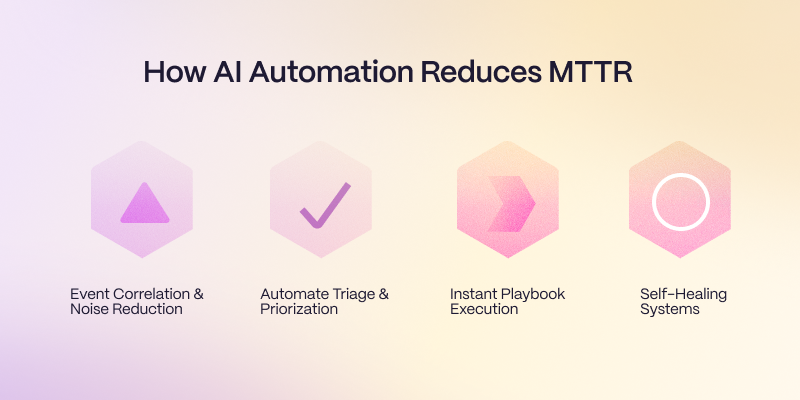

The Hidden Costs of Immature Incident Management
The start of a journey towards a mature SRE practice.
Every second of downtime has a measurable cost. For modern IT teams, especially Site Reliability Engineers (SREs), DevOps engineers, and incident managers, reducing that downtime is both a performance goal and a business imperative. AI in incident response combines artificial intelligence with automation to detect issues faster, predict failures before they occur, and resolve incidents with minimal manual intervention. By integrating incident management automation and real-time monitoring, organizations can proactively safeguard uptime and prevent small issues from becoming critical outages.
One of the most important metrics in this process is Mean Time to Resolution (MTTR), the average time it takes to restore service after an incident. High MTTR can lead to SLA breaches, customer churn, and revenue loss. AI-powered response tools help reduce MTTR by correlating alerts, automating triage, and executing predefined remediation steps. This combination of speed, accuracy, and consistency enables teams to resolve incidents significantly faster than with manual methods, improving service reliability and overall operational efficiency.
Key Takeaways:
.png)
AI in incident response introduces capabilities that go beyond traditional monitoring and manual troubleshooting. By leveraging machine learning models, pattern recognition, and automated decision-making, it enables teams to detect, diagnose, and address incidents before they escalate. These capabilities work together to enhance system resilience, reduce noise, and accelerate recovery times.
AI can identify patterns in historical logs, performance baselines, and telemetry data to forecast potential issues before they cause service disruption. This proactive approach allows teams to apply preventive measures, schedule maintenance, and avoid costly outages.
Machine learning algorithms continuously analyze incoming data from distributed systems, detecting unusual activity without relying solely on fixed thresholds. This means AI can spot subtle deviations — like micro-latency spikes or gradual memory leaks — that human operators or static rules might miss.
During an active incident, AI provides contextual recommendations for incident commanders and on-call engineers. These can include likely root causes, suggested remediation steps, and impact forecasts, enabling faster, more informed decisions.
Mean Time to Resolution (MTTR) is the average amount of time required to restore service after an incident, from the moment an issue is detected to the point it is fully resolved. In incident management, MTTR is more than just a technical performance metric — it is a measure of an organization’s resilience, operational efficiency, and ability to maintain user trust. Lower MTTR means faster recovery, fewer SLA violations, and reduced risk of long-term business damage.
MTTR formula:
MTTR = Total downtime for all incidents / Total number of incidents
This calculation provides a clear, measurable indicator of how quickly your team can return to normal operations after a service disruption.
The economic impact of downtime is steep:
The longer the MTTR, the greater the risk of compounding damage — from revenue loss to reputational harm. In industries with strict SLAs, exceeding downtime thresholds can also trigger significant penalty fees.
Within Google’s Site Reliability Engineering (SRE) framework, MTTR is considered a critical health metric tied to error budgets and service level objectives (SLOs). A low MTTR signals strong incident response maturity, streamlined escalation paths, and effective monitoring systems. Conversely, a high MTTR often indicates gaps in visibility, inefficient triage processes, or inadequate tooling.
From the customer’s perspective, MTTR is an invisible but powerful factor in satisfaction and loyalty. Frequent or prolonged outages — even with prompt communication — erode confidence in the service. For competitive markets where alternatives are readily available, a single high-impact incident can push users toward competitors.
Speed is not just about restoring service quickly; it’s about minimizing the ripple effects of disruption. Rapid resolution reduces operational overhead by preventing a backlog of recovery tasks, lowers the stress and burnout risk for on-call engineers, and ensures post-incident analysis can begin sooner. This, in turn, accelerates continuous improvement cycles.
For IT leaders and incident managers, reducing MTTR is one of the most direct ways to protect revenue, maintain SLA compliance, and safeguard brand reputation. In the context of AI and automation, shortening MTTR also means freeing up human talent to focus on higher-value strategic work rather than repetitive firefighting.

AI-powered automation transforms incident response from a reactive process into a proactive, self-optimizing workflow. By correlating events, prioritizing critical issues, executing remediation steps instantly, and even initiating self-healing actions, AI eliminates the manual bottlenecks that extend Mean Time to Resolution (MTTR).
Modern IT environments generate thousands of alerts daily from monitoring tools like Prometheus, Datadog, and Splunk. Many of these are duplicates or low-priority warnings. AI uses advanced pattern recognition to group related alerts into a single actionable incident, allowing teams to focus on the root cause instead of chasing multiple false leads.
Once an incident is identified, AI evaluates its severity based on affected systems, business impact, and historical resolution times. It then prioritizes response actions accordingly. This ensures that high-impact outages are addressed first while lower-priority issues are queued for later resolution.
Automated runbooks execute predefined recovery steps without waiting for human intervention. These steps can include restarting failed services, rolling back deployments, clearing cache layers, or scaling infrastructure resources.
The most advanced AI incident response setups include self-healing infrastructure that detects, diagnoses, and resolves certain classes of issues autonomously. This can involve traffic rerouting, configuration restoration, or database recovery — all without human touch.
The right AI tools for incident response combine monitoring, event correlation, automation, and remediation into a unified workflow. They integrate with existing observability stacks, ITSM platforms, and communication tools, enabling faster detection, triage, and resolution of incidents. Below are some of the leading options IT leaders, SREs, and DevOps teams rely on to cut MTTR.
When selecting an AI-powered incident management tool, consider:
While AI-powered incident response delivers measurable gains in reducing MTTR, it also introduces potential pitfalls if not implemented thoughtfully. Automation can amplify both strengths and weaknesses, making it essential to identify risks early and put safeguards in place.
An improperly tuned AI system can misclassify harmless anomalies as urgent issues, flooding teams with unnecessary alerts. This not only drains productivity but also desensitizes engineers to real emergencies.
Mitigation: Begin with supervised learning, where AI suggestions are reviewed by humans before execution, and continuously retrain models using recent incident data to improve accuracy.
If remediation logic is flawed or fails to account for rare edge cases, automated actions could escalate a problem instead of fixing it. Over-dependence also reduces hands-on experience, making teams less prepared for novel incidents.
Mitigation: Keep humans in the loop for high-impact responses, and periodically run manual drills to maintain skills and situational awareness.
Incident data often contains sensitive system or customer information. Feeding this into AI tools without strict controls can create compliance violations under GDPR, HIPAA, or SOC
Mitigation: Partner only with vendors that provide robust encryption, role-based access, and documented compliance certifications.
Engineers may resist automation due to concerns over control, transparency, or job displacement.
Mitigation: Position AI as an augmentation tool, involve engineers in rule-setting, and offer training that highlights how automation reduces repetitive work rather than replacing human expertise.

Deploying AI in incident response requires more than plugging in a tool — it’s a structured change management process. These best practices ensure automation delivers measurable MTTR reductions without introducing new risks.
Automate repetitive, predictable tasks first, such as log aggregation, alert deduplication, and health checks. This builds trust in the system while demonstrating clear time savings.
Choose AI tools that work seamlessly with your monitoring, alerting, and ticketing platforms. Integration with tools like Jira, ServiceNow, Slack, or PagerDuty ensures automation fits naturally into existing workflows.
In the initial rollout, require human approval for critical remediation actions. Over time, gradually expand automation autonomy as confidence grows in its reliability.
AI models improve with data. Feed them updated incident logs and postmortems to refine detection, triage, and remediation accuracy. Regular reviews prevent drift and false positive spikes.
Document every automated workflow, its triggers, and expected outcomes. Maintain version control for runbooks and remediation scripts to ensure traceability.
Track MTTR, false positive rates, and automation coverage. Share success stories internally to encourage

The role of AI in incident response is rapidly evolving. What is considered advanced automation today — real-time anomaly detection, event correlation, and automated playbook execution — will become baseline capabilities in the near future. The next wave of innovation will focus on making incident management not just faster, but increasingly autonomous and context-aware.
Emerging self-healing infrastructure aims to identify, diagnose, and resolve certain classes of incidents without any human intervention. These systems will not just react to problems but adapt dynamically, learning from each event to improve future outcomes.
Future AIOps platforms will integrate IT operations, security events, application performance, and business KPIs into a single decision-making framework. This unified view will help teams resolve issues based on overall business impact rather than isolated technical metrics.
Generative AI will soon draft blameless post-incident reports in real time, highlight systemic weaknesses, and propose preventive strategies. These AI-generated insights will shorten postmortem cycles and create richer knowledge bases for training and process improvement.
As predictive models mature, AI will shift incident response from reactive firefighting to preventive incident management, where potential failures are remediated before they impact users. This will blur the line between incident detection and continuous optimization.
Reducing Mean Time to Resolution is not just an operational metric — it is a direct driver of business continuity, customer trust, and revenue protection. AI in incident response brings together rapid detection, intelligent triage, and automated remediation, enabling teams to restore service faster and more consistently than ever before. When deployed with clear governance, regular model tuning, and human oversight, automation becomes a force multiplier rather than a risk factor.
Organizations that embrace AI-powered workflows today will see immediate MTTR improvements and build the foundation for the next generation of autonomous, predictive, and self-healing IT operations. In an environment where every second counts, the ability to prevent and resolve incidents before they impact customers will set apart the true leaders in service reliability and operational excellence.